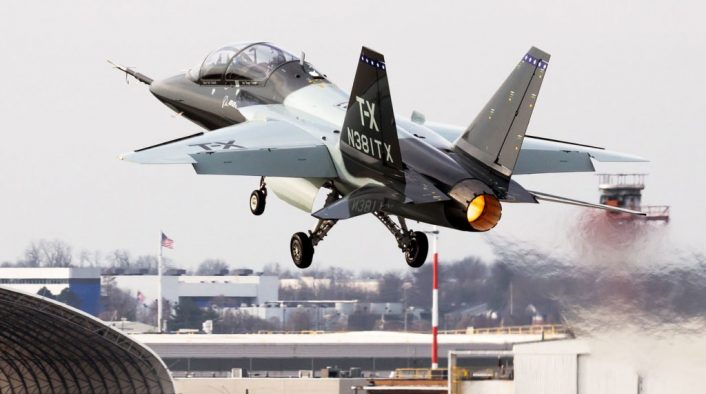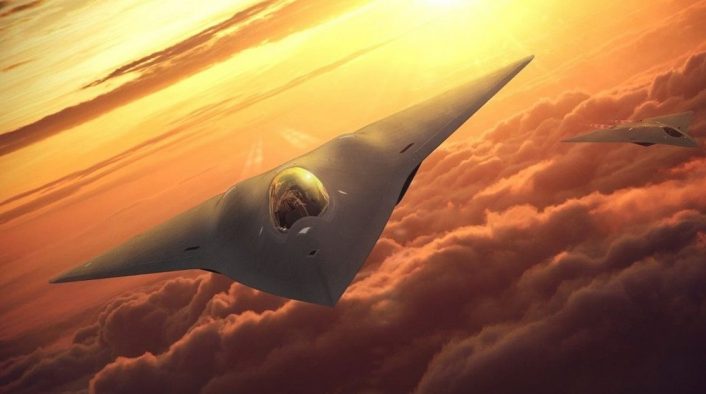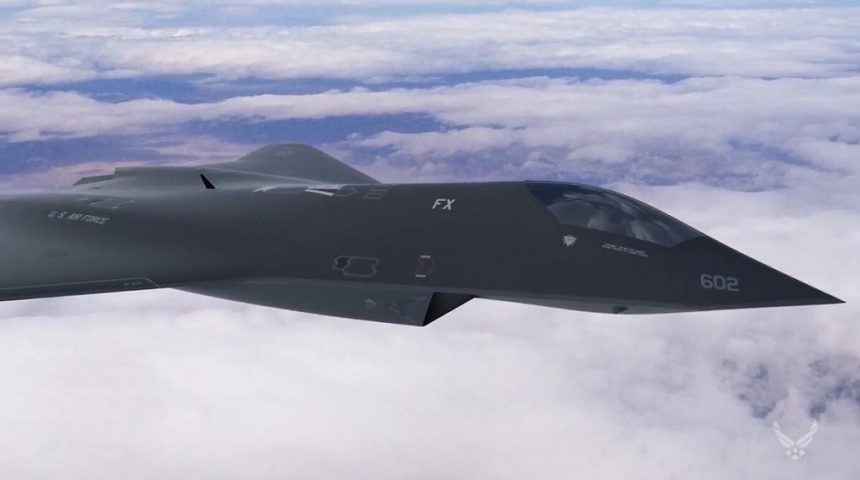The Digital Century Series, or simply e-Series, is meant to facilitate the U.S. Air Force and Space Force’s analog-to-digital metamorphosis.
In September 2020, Dr. William Roper, Assistant Secretary of the Air Force for Acquisition, Technology and Logistics and Secretary of the Air Force Barbara Barrett announced for the first time the “e-Series” or “Digital Century Series”. To better explain the concept, Dr. Roper wrote a guidebook, inspired by the 1999 film “Matrix”, which he titled “There is No Spoon”.
According to the document, the T-7A Red Hawk is the first aircraft designed following this new concept, and for this reason it obtained the designation eT-7A. Digital engineering allowed the eT-7A to be digitally designed and built in just 36 months, something that was not accomplished since the 1950s, with third-generation fighters called the “century series”.
Now, as a follow-on of the first guidebook, Roper wrote another one which he called “Bending the Spoon”. In “There is No Spoon”, Roper says that the T-7A was not the only digitally engineered program, mentioning also the Next Generation Air Dominance (NGAD) and the Ground Based Strategic Deterrent (GBSD) among them. In the new guidebook, he explicitly writes that the NGAD, GBSD, A-10 Re-wing Program and B-52 Commercial Engine Replacement Program (CERP) met the requirements to achieve the e-series status.
The NGAD is the U.S. Air Force advanced sixth-generation full-scale flight demonstrator that was digitally engineered and made its first flight years ahead of expectation, as announced in September. Taking inspiration from the T-7A, the NGAD program is attempting to increase the frequency of new military aircraft competitions, allowing the Air Force to rapidly develop and buy aircraft more frequently. Thanks to new improved development and manufacturing techniques buying new fighter jets approximatively every eight years and replacing them every 16 years, without the need for service life extensions or mid-life updates after the 3,500 flight-hour mark.
According to Dr. Roper, the new approach of continuous development of the Digital Century Series could cause an increase of 25% of the development costs and 18% of the production costs but could also lead to a 79% reduction of modernization expenses and 50% of the sustainment costs. Another important advantage is a much younger fleet of combat aircraft.
NGAD and the entire Digital Century Series revolve around three principles, which Roper called “the digital trinity”: agile software development with full digital threading based on containerized software continuously developed, tested, released and updated based on the feedback (Kubernetes are an example); open architecture systems with modular government-owned reference hardware and software that allows rapid upgrades and integration of new capabilities; and digital engineering, or the use of advanced CAE and Digital Twin concepts.

The most important digital engineering principle being followed by the Air Force and Space Force is mentioned in “Bending the Spoon”: “Digital Engineering must achieve a measure of authoritative virtualization that replaces, automates, or truncates formerly real-world activities.” With this principle in mind, Roper wrote it was possible to unlock the performance of the e-Series programs.
“Digital engineering takes computer creation technology to the next level, rendering not just the design of complex systems, but their assembly, environment and even physical performance in high-powered virtual reality,” Roper writes.
While Computer Aided Design (CAD) tools had been widely used since the 1960s, they were never able to replace physical testing. However, the rapid increase in computer processing , especially with the advent of digital threads and digital twins, made it possible to replace real-world prototyping and testing with authoritative virtual sources of truth. A real application of this design philosophy is Formula 1, with hundreds of digital cars being explored each racing season, but only one built in the end. Roper mentioned this as an inspiration for the military e-Series.
“Strategically, you are looking to flip the current acquisition paradigm – exchange real-world activities with digital – for speed and agility,” Roper wrote. “Speed and agility are greater weapons – and more to be feared in future militaries – than any individual system we could build.”
To achieve this, a digital foundation is required, described as “the infrastructure, policy, training, and culture that enables digital acquisition, digital engineering, and e-Series”. Once this foundation had been laid out, the core construct can be introduced: “Authoritative Virtualization is a digital model of a system that renders its inputs, operational environments, and internal functions and behaviors – along with all subsystems necessary to capture them – such that outputs can be certified as predictive.”
The basic building blocks of the virtualization must be quantitatively understood, but that does not preclude the use of legacy systems that are not fully virtualizable. Examples of this are the B-52 Commercial Engine Replacement and the A-10 re-wing programs. In either case, if the operating environment or internal elements affect the outputs, they require authoritative modeling or empirical data for the virtualization to work. That does not imply that everything must be modeled, but simply that a certain level of errors should not be exceeded for the virtualization to substitute for reality. This can be done by following a digital building code, certified by the Air Force and Space Force.
Automation has been described by Roper as a special case of virtualization, which has the powers to accelerate digital acquisition. Although nearly all functions within a program’s lifecycle may be virtualized, not all may be automated yet. Many things may be automated, with an example being the CloudONE/PlatformONE system, accelerating the delivery while lowering cost and risk. Most things can at least be partially scripted and, even if human oversight should still be required, there could be significant personnel savings.
Once real-world activities have been replaced, truncated, or automated via virtualization, for a program being declared an e-Series is simply a final assessment by the Milestone Decision Authority. And here Roper provides the motive behind the designation of the e-Series: “certified e-Series should help propel the Air Force and Space Force’s analog-to-digital metamorphosis.”
The comparison here is with our phones, cars and homes, which picked up the preface smart as they explored the new possibilities offered by Internet and the new technologies. Today the use of smart has been greatly reduced because it transformed the modern tech and has done its job in obtaining a widespread use of the connected technologies. The same concept is being applied to the e-Series, with the “e- “ prefix before the aircraft’s name being dropped once the military analog-to-digital metamorphosis is completed and the new design and acquisition concept becomes the norm.

In a sidenote, Roper details the prefix’s usage: “With regard to e-Series naming conventions, whether or not we apply the ”e-” prefix to the name of platform or program will be based on degree of digitization and common sense. eT-7a and NGAD merit the formal name change with the ”e-” in the platform name. Whereas, “eCERP” is more appropriate than “eB-52”. Programs should feel free to add and drop prefixes as convenient based on context. The achievement is more important than the prefix or name.”
As a recap, here are the 14 principles for authoritative virtualization that helped the T-7A and the NGAD to achieve the e-Series status:
- Every system virtualization has a starting point — its basic building blocks — and those building blocks must be quantitatively understood.
- Whether internal or external, if the operating environment affects outcomes or performance, you must either model its physics-based rules or account for it via empirical data.
- Whatever you are virtualizing, if it contains internal elements that affect outputs, they inherit the same analytic burden, requiring authoritative modeling or verified anchoring data.
- Just as construction architects and engineers obey building codes certified by local governments, our digital models and infrastructure must obey a similar “digital building code” that is certified by the Air Force and Space Force. This is the pith of “owning the tech stack” and paramount because safety and mission success may depend on our models, in addition to cost.
- Owning the tech stack — at a minimum, the government reference architecture by which underlying models and software are built — and even furnishing the digital environment itself, especially for software and automation, is the best way to enforce our digital building code, especially at scale.
- Automation is a special case of virtualization, but one with special powers to accelerate digital acquisition.
- Absent required human judgment or critical thinking, activities we can turn into computerized checklists may be automated.
- Even should human oversight still be required for automated outputs, the net personnel savings should still be game-changing.
- Authoritatively automating “Government-as-a-Service” functions requires furnishing our tech stack — or at least automation layers — to industry to overcome legal hurdles.
- Information Technology, now and in future, is a warfighting system — so it must be bought for overmatch, not as a “technically-acceptable” business commodity.
- Once a model is built to digital code, whether or not it is predictive is a matter of test data, which can vary widely between programs and functions.
- Polarity of testing changes in digital acquisition. In the past, systems were physically tested to graduate from models. Today they should be tested to graduate to digital models.
- Once you have replaced, truncated, or automated real-world activities via virtualization — the art of digital engineering — being declared an e-Series is simply a final assessment by the Milestone Decision Authority.
- Certified e-Series should help propel the Air Force and Space Force’s analog-to-digital metamorphosis.
You can read more about the U.S. Air Force and Space Force use of digital engineering and e-Series in the two guidebooks, “There is No Spoon” and “Bending the Spoon”, wrote by Dr. Roper and published on the USAF website.









